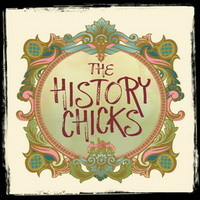by The History Chicks | Mar 8, 2013 | Biography Episode, Episode, News, Podcasts, Shownotes
Once a season we step away from factual subjects and focus on a fictional one. This season we traveled to the land of Oz and took a look around.
“But Chicks,” you say,”a Wizard is a man.”
To that we respond: Thank you for pointing this out. Yes, the Wizard is a man, and L. Frank Baum is a man…but Oz is full of women! Dorothy! Glinda! Ozma! Oz is a land of female rulers and strong charactered inhabitants- how could we not talk about it? (Besides, we like fantasy, okay? And there are several points in the Six Degrees of History Chicks Separation game with this subject. Just trust us.)

W.W. Denslow illustration from The Wizard of Oz by L. Frank Baum
We’re sure several images popped into your head when you saw the title, and we will cover most of them in this episode…except three: Judy Garland, Billie Burke and Margaret Hamilton. We decided to have a separate conversation about the lives of the three female stars of the 1939 movie . That chat will be posted as a companion minicast .
In 1900 L. Frank Baum introduced the world to the imaginary land of Oz. It wasn’t the first children’s book that he had written-but it would become a series that he would work on for the rest of his life that is full of characters, settings and storylines that are still being explored today.
Born in 1856 in Chittenango, New York, Lyman Frank Baum was the son of a barrel maker and occupational experimenter who struck it rich in the oil business- Benjamin Baum and his wife, Cynthia Stanton Baum. Frank was a sick child with a weak heart but a big imagination. He also had the gift of very indulgent parents.
Aside from a short stint at Peekskill Military Academy (where there was, literally, a yellow brick road), Frank was educated at home by tutors and parents who helped him peruse any interests he had. When he took an interest in the printing process, his parents bought him a home printing press. Later when he took an interest in acting, they got him a theater.

Franks brief experience in a military school…not exactly his thing
Once grown, he began touring with an acting company until he met Maud Gage- daughter of Elizabeth Cady Stanton’s co-author Matilda Jocelyn Gage. Love. Within a year they were married, and when she became pregnant with the first of four sons, the acting life ended and Frank the dreamer needed to become Frank the supporter.
He did not find success as a chicken breeder, store owner, newspaper man, or traveling salesman. One day he wrote out the Mother Goose rhymes that he had been sharing with his sons and they became his first book- Mother Goose in Prose. His second was a spin-off of that one, Father Goose: His Book.
Shortly after these two successes, he wrote down the stories he had been telling his sons and the neighborhood kids about a little girl named Dorothy in a magical land named Oz. With clever illustrations by W.W. Denslow, The Wizard of Oz was a hit.
Frank brought the story to the theater with a stage version ( although the adult cast wasn’t exactly what he had in mind when he wrote the story), and this also was a success. While he had no interest in writing another Oz book, he did have an interest in putting food on the table for his family. Frank Baum was an imaginative writer, but a businessman he was not and he would earn and lose his wealth many times over the years. Within four years of the first Oz book he was publishing a second. He would write 13 sequels to the original story (including our favorite- Ozma of Oz).
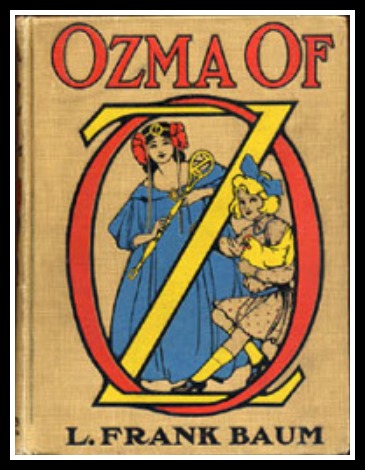
Shh, don’t tell the others, but this is our favorite
But that’s not all! Frank wrote several books and plays under pseudonyms and several of those were women’s names- the most successful being a series for teenage girls, Aunt Jane’s Nieces, under the pen name, Edyth Van Dyne.

L. Frank Baum circa 1911
Frank Baum died on May 6th, 1919 at the age of 92. His last book, Glinda of Oz, was published posthumously a year later.
But the Oz books couldn’t end! Not only was the world enthralled with the story, it was making some serious coin for its publishers. After Frank’s death another 36 books would be written by a variety of authors making up what is considered the official 40 book Oz series.
About 38 years down the yellow brick road technology caught up with the stories. After Walt Disney scored big time with Snow White, movie makers were looking for the next big fairy tale and MGM landed Oz. We geek out about the making of this iconic movie for quite a while during the podcast. We chat about trivia as well as the differences between the movie and the beloved books (Like the shoes: Dorothy originally was gifted a pair of silver shoes, but red showed up so much nicer in Technicolor.)
2.6 million dollars, five directors, scores of writers, two Tin Man actors, and a shooting schedule that stretched from 6 weeks to 23 The Wizard of Oz finally opened…
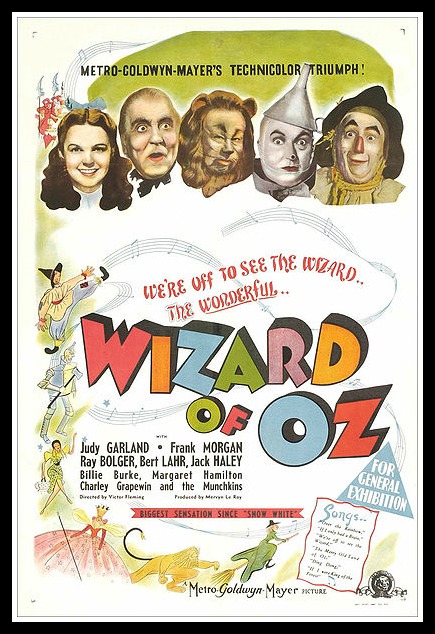
Not the first technicolor movie by a long shot and didn’t follow the books exactly (and we cover those differences in the podcast), 1939 MGM movie poster
…and didn’t quite do as well at the box-office as you would have expected. While this film lasts on mostly due to annual televised showings beginning in the mid 1950’s- the movie wasn’t a flop by any standard, but it did originally fail to be a financial success. The movie did win two Academy Awards as well as a special award for 16 year-old Judy Garland.
TIME TRAVEL WITH THE HISTORY CHICKS
So you really don’t want to read all the books in the Oz series, we get that- 40 is a lot of books. Here is a really fun shortcut to the plots and characters of each book as well as all the original cover art to them. Maybe after you read these reviews you will give in and get one of the books. And another. And another. Hey, fantasy series are all the rage these days- there is a reason and Oz started them all. Mari Ness on TOR.COM
Other than the books in the Oz series, we didn’t have a lot of recommendations for this episode. We think that the Annotated Wizard of Oz was pretty terrific, as well as the Wicked Years series by Gregory McGuire and Was by Geoff Ryman (very dark, but very good).

Annotated Wizard of Oz edited by Michael Patrick Hearn
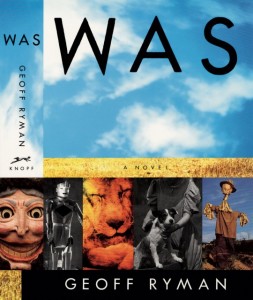
Was by, Geoff Ryman
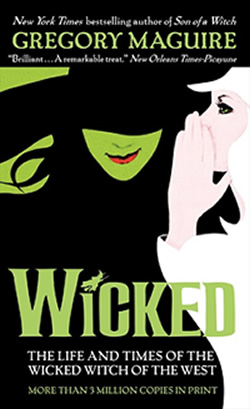
The Wicked Series by Gregory Maguire (also available on Audible.com and you can get a free book just by clicking the link to the far right, no, up higher…just sayin’)
And as far as movies go, get thee to the library and borrow the 3 -disc Collector’s Edition of the 1939 movie! So many special features you will be all Oz’d up in no time!
1978 brought a very interesting version of movie (it had previously been an Tony award winning Broadway play) The Wiz starring Diana Ross and Michael Jackson. Make your own judgement if it’s destined for Cult Movie Classic status or not.
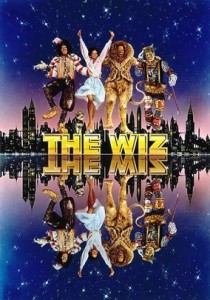
1978 musical The Wiz
You can catch Tin Man, the Sci-Fi channel mini-series starring Zooey Deschenel, streaming on Netflix and decide if you think it’s good (and forgive Zooey for this one) like Susan, or if you can’t get past the first episode like Beckett.
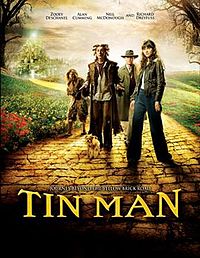
Classic Oz touches sprinkled through story in semi Once Upon a Time style
Join in the serious business at the International Wizard of Oz Clubs, or join some chat with the Royal Historians and all at The Royal Website of Oz.
The Studio 360 podcast episode “American Icons: The Wizard of Oz” can be found here, or on ITunes: Studio 360
Want to read the rest of the Evil Overlord list? Find it here: The Evil Overlord List
Investigate your name’s popularity over time at The Baby Name Wizard (warning! It’s addictive!): Baby Name Wizard
Finally, there are a pair of the Ruby Slippers Judy Garland wore in the movie at the Smithsonian, but if you are looking for an Oz museum as you cross Kansas, here is one in Wamego, Kansas ( just east of Manhattan). We have not been, but if you have let us know how it is in the comments!
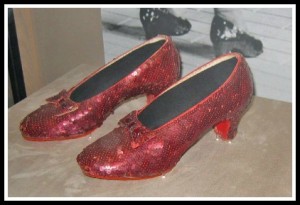
On display in Washington, one pair of the movie ruby slippers
As always, our music comes courtesy of Music Alley. Visit them at music.mevio.com
(closing song – If I Only Had a Brain by Elijah Tucker)
by The History Chicks | Feb 14, 2013 | Podcasts
by The History Chicks | Feb 13, 2013 | Biography Episode, Episode, Podcasts, Shownotes
Before there were suffragists to march and fight for the vote, there was Elizabeth Cady Stanton. Before she teamed up with another superhero for women’s rights, Elizabeth was a daughter, a sister, a wife, and a mother. Then, one warm summer day in 1848 in Seneca Falls, New York she stood up, gave her first public speech and helped to start a movement.
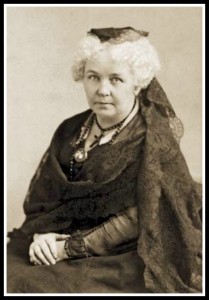
Elizabeth Cady was born in November 12, 1815 in Johnstown, NY. She was the eighth of eleven children of Daniel- a lawyer and judge- and Margaret Cady. All but one of their sons died in infancy and Daniel’s hope rested on his surviving son, Eleazar. That hope was crushed when he, too died at the age of 20. Elizabeth, then 11, couldn’t understand why she couldn’t fulfill the hopes of her father who said to her, “I wish you were a boy.”
She tried- she rode horseback and tried to do “boy” activites. She studied hard and excelled academically but there was one thing that she couldn’t control and it was the one thing that held her back: her gender. Once she exhausted the educational options that she had, Elizabeth became involved in the Abolitionist and Temperance movements and began down a pretty traditional path when she married Henry B. Stanton.
Well, sort of traditional- except that she and Henry, a Reformer working to abolish slavery, took the word, “obey” out of the traditional vows, and their first voyage after marriage was to London for a World Anti-Slavery Convention. How’s that for a honeymoon? Of course, there is a lot more to the story (A LOT- we tell you this every time, you have to listen to the podcast to get all the juicy bits)- but while in London Elizabeth’s eyes were opened to several things. The one that impacts this tale, is the way that women were treated- even delegates at the convention who were female were not allowed to participate in any more than an observational role. She also met some rock stars in the human rights arena but during her time not participating in the proceedings, she and Lucretia Mott- a Quaker preacher who was very active in the anti-slavery movement- formed a friendship that would have a significant impact on Elizabeth’s life in a few years.
But first Elizabeth lived the married life of the wife of a lawyer in Boston. She had three children in short order and set up housekeeping in the city. She enjoyed her life a great deal- hello!- she was hobnobbing with the likes of Nathaniel Hawthorne and Ralph Waldo Emerson. But all good things must end and the family moved to Seneca Falls, NY (upstate, to the left- about halfway between Albany and Buffalo). In this new phase of her life she wasn’t as content as she had been in the city. She kept having babies (seven in total), but lacked the staff , support and outside interests that she had in Boston. Henry traveled a great deal as an anti-slavery lawyer and politician- and Elizabeth got caught up in the drudgery of small town life.

Elizabeth and two of her boys around the time of the First Women’s Rights Convention
One day, her old friend Lucretia Mott came to town and Elizabeth was invited for tea with her. Shortly after this the women present had created, advertised and were holding the First Women’s Rights Convention in Seneca Falls (if this story is new to you, THIS is one of the historical turning points that President Obama was referencing in his 2013 inaugural speech). In front of an audience of about 300 people who had packed into the Wesleyan Chapel Elizabeth wrote and delivered her first public speech ever, the Declaration of Sentiments based on Thomas Jefferson’s Declaration of Independence. The points outlined in the speech were designed to create laws that protected women and put women on equal footing legally with men. And the biggie? The right to vote.
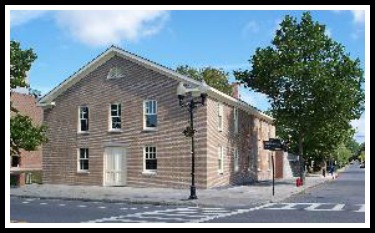
Now part of the Women’s Rights National Park, the Wesleyan Chapel held the first Convention. (photo courtesy nps)
From where we are sitting suffrage for women seems like a no-brainer, but in this time it was fairly scandalous. Women at the time were not considered intelligent enough to sit on a jury, let alone own property, have a legal say in the welfare of their own children, or help to decide the government of their own country. 100 people signed the Declaration that day, mostly women but some men- vowing to do what they could to create change. Elizabeth, however, was torn. She was becoming rather famous for her speech but she felt strong devotion and loyalty to her family. How could she help the cause when her primary responsibilities required her to stay home?
Enter one Susan B. Anthony. The two met one day and not only was a friendship formed- but a partnership. Elizabeth could write the words, and Susan- who was single and not tied to family obligations- could travel to deliver them. Elizabeth would later say, “I forged the thunderbolt, she fired it.”
For the next 50 years the two would work together on the cause of women’s rights.
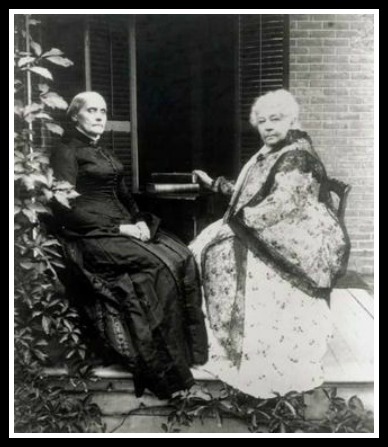
Susan B. Anthony and Elizabeth later in life, they even look like the opposites that they were, don’t they?
It wasn’t easy, and they would often disagree. For instance, at one point Susan thought that the sole mission should be to get women the vote, while Elizabeth thought more broadly to religious and legal freedoms. But work together they did. For the most part, Susan did the leg work and Elizabeth did the brain work. But often Susan would travel to Elizabeth’s home and help out with domestic chores so that new speeches could be written.
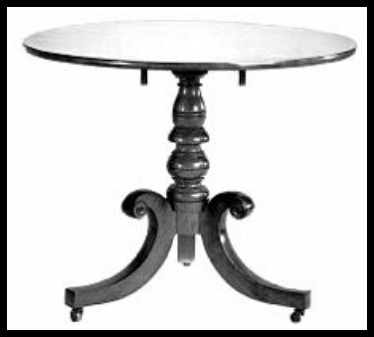
The mahogany table that the women would work at at Elizabeth’s house and where Elizabeth wrote the Declaration. It later was at her funeral.
During that time they put in years of hard work, devotion, standing up for what they thought was right all with a goal of women’s suffrage in their minds and actions. It’s a long story and we go into some detail during the podcast, but it is filled with success and failure; determination and drive; support and alienation from those who they encountered; work for not only women’s suffrage but temperance and abolition, too. Elizabeth did it all while raising her family without much help from her traveling husband.
As the two women slowed down, just a bit- they got together to document the tale of the work done thus far in a book that would take years to write- The History of Women’s Sufferage. Susan managed to vote in an election, although she was famously arrested, charged and fined $100 for her attempt. Elizabeth spoke throughout Europe and caused quite a ruckus when she re-wrote the Bible into The Women’s Bible offering counter-discussions for time honored interpretation of scripture from Genesis to Revelation. She also wrote her memoirs, Eighty Years and More. Together they wrote a document and got it into the rights hands to be presented to Congress. This little document, very short, but very important, would be presented in every session for the next 45 years.
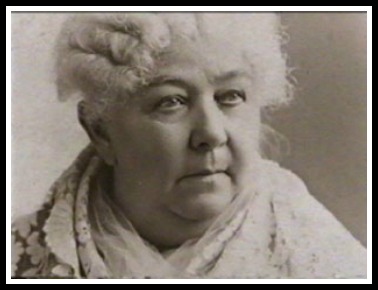
On October 26,1902, Elizabeth was 86 years old and living in New York City with her daughter. She was losing her eyesight and in constant need of physical assistance. She asked for assistance to stand, took in the view for several minutes, then was instructed by her family to sit she lay down and took a nap. That day she died in her sleep.
Susan would carry on the fight for the next four years, dying in 1906.
In 1920 the document that they had prepared was finally ratified and became the 19th Amendment to the Constitution granting women the right to vote.
TIME TRAVEL WITH THE HISTORY CHICKS
Companion podcast! Beckett reads the Declaration of Sentiments in a companion podcast. CLICK HERE .
Museum! If you happen to be near Seneca Falls, NY, you have to (have to…must, really!) visit the Women’s Rights National Historic Park. There are four properties including Elizabeth’s house and the Wesleyan Chapel where the first Women’s Rights Convention was held.
If you are interested in reading some of the works of Elizabeth Cady Stanton, try The Papers Project or the National Archives Teaching with Documents site. A History of Women’s Suffrage and The Women’s Bible are in the public domain and can be read through Project Gutenberg.
One of the organizations that Elizabeth helped to found and was the first president, The National American Women’s Suffrage Association morphed after the 19th Amendment into the League of Women Voters and is still an active organization today.
THE 19th Amendment!
Movies- we recommend this one Ken Burn’s documentary that is streaming on Amazon (Or get it from your library), Not For Ourselves Alone: The Story of Elizabeth Cady Stanton and Susan B. Anthony.
Books!
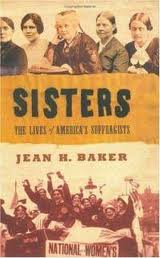
Sisters: The lives of America’s Suffragists by Jean H. Baker
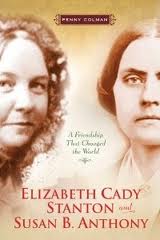
Elizabeth Cady Stanton and Susan B. Anthony: A Friendship That Changed The World by Penny Colman
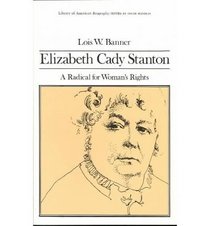
Elizabeth Cady Stanton: A Radical for Women’s Rights by Elizabeth Griffith

Elizabeth Cady Stanton:An American Life by Lori D. Ginzberg
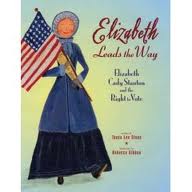
Kid’s book Fave: Elizabeth Leads the Way by Tanya Lee Stone illustrated by Rebecca Gibbon
And finally, Elizabeth is in this book- but so are many others, but it’s just a great read (and if you have anyone else attributed to this quote than the author of this book on your Pinterest boards- go change it now!)
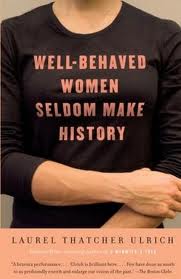
Well-Behaved Women Seldom Make History by Laurel Thatcher Ulrich
Susan here. I stand corrected. The dance that my kids learn in physical education not history class in middle school is the Cotton Eyed Joe. Not necessarily a Missouri dance but one that originated in the south prior to the Civil War with probable slave origins. I still think it’s wonderful that a folk dance is taught, and remembered in this day and age. Take that Cupid Shuffle and we’ll see where you are in 150+ years.
As always music comes courtesy of Music Alley. Visit them at music.mevio.com
by The History Chicks | Jan 21, 2013 | Episode, Podcasts
In this episode we continue our chat about the many acts in the life of Josephine Baker. When we went to intermission, Ms Baker was touring the world as an entertainment superstar with the help of her manager/fake husband/fake Count, Pepito Abatino. The one place that she had left to embrace her was her native country, the good ol’ US of A. When the house lights went up we were biting our nails! Would her homeland love and appreciate her as much as the people of other continents? Could Josephine go home?

Act Three
(It’s 1934 and Josephine is taking the stage at the Ziegfield Follies in New York expecting a warm and loving response)
Crickets chirp.
Josephine didn’t have to get far onto US soil before she faced racial prejudice. As a ‘married” couple she and Pepito could share a hotel room, but not an entry door into the hotel. Her performances were not met with a warm reception for a variety of reasons: she danced with white male partners, her level of undress made audiences uncomfortable, and the songs that she was required to sing were not suitable for her voice. Her part in the show was your basic hot mess. Josephine blamed Pepito and sent him away, back to France ending their ten year relationship…and quite possibly his life. He was hospitalized and died of unknown causes a few weeks later. Stomach cancer or a broken heart?
Josephine got out of her contract and the US as quickly as possible. Shortly afterward she married Jean Lion, a wealthy French businessman. With this marriage she legally became a French citizen and had hopes of becoming a mother. Jean apparently had high hopes of her becoming his most fabulous accessory, a trophy wife. But first, Josephine must say good-bye to her public and set off on a farewell tour.
The only thing that fully got the good-bye and farewell part is the marriage; it doesn’t last long.
But our newly minted French citizen had some very important work in her future. WWII began and she volunteered to assist the war effort for her country. Her touring continued from country to country with one major difference: She was doing it as a spy for the French Resistance. She used her lifestyle of hobnobbing with those in the know to get intel and smuggled it back with her hat boxes and costumes, and eventually raised in ranks within the French Free Air Force.
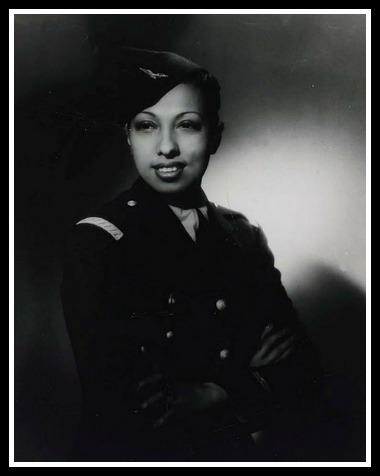
Josephine in uniform
As always we go into much more detail in the podcast but essentially her spy duties came to a halt when she was hospitalized in Casablanca for 19 months.
But that wasn’t the end of the war efforts of our heroine! Once recuperated, she went back on the road, this time helping to spread a message of brotherly love by entertaining racially integrated audiences of soldiers. Ultimately she received two prestigious awards for her work in the war, the Croix de Guerre and the Medal of Resistance. And by the end of the war, she entered her fourth marriage, to her band conductor- Jo Boullion.
The war ws over, but Josephine still has some fight in her. At this point in her life, she directed it toward the fight for racial equality. She not only had lofty goals she had big…no, massive plans.
First she and Jo remodeled an old castle she named Les Milandes, in the south of France, into a tourist destination with a theme of brotherly love. This pricey undertaking required some capital, so off she went on another world tour. This time she was confronted with more racial barriers and opportunities for her to use her celebrity. One, an incident in New York’s famous Stork Club that involved then popular newscaster, Walter Winchell, got her banned from reentering the US for many years. (It’s a doozie, and we gossip on about the details in the podcast)
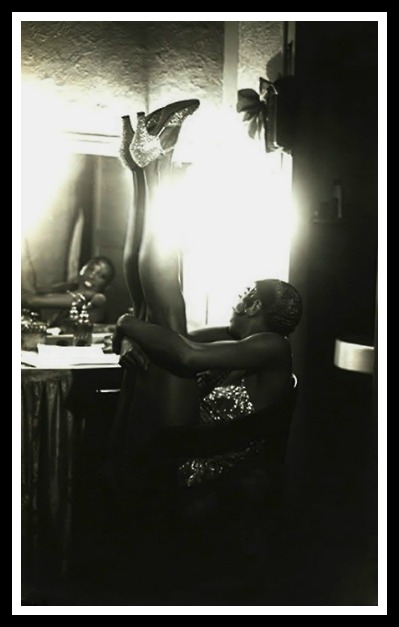
Next up, Josephine embarked on a plan to finally put herself in the role of a lifetime: Mother. She and Jo began to adopt babies of all colors and nationalities from around the world. They named the TWELVE children, The Rainbow Tribe.

Jo and Josephine with their young, and as yet incomplete, tribe
But it’s not all rainbows and sunshine for this unique family.
Act Four
(Open on Jo driving away from Les Milandes, Josephine and 12 stunned children left in his wake)
Josephine and Jo didn’t see eye-to-eye on many things. Ahem, many – but one important one being the children: How many? How to raise them? When was enough enough? When Josephine was on tour, the children were raised by Jo and a series of nannies at Les Milandes. Mama would breeze in, sometimes with a new brother or sister- take a few pictures, love on them all, then go back on the road. The costs of the constant renovations to the castle were astronomical, and eventually she was so far in debt she couldn’t get ahead. Jo couldn’t understand her, deal with her, take it- whatever his reasons, he left – although they never divorced.
On one hand she had this falling down resort that is getting her more and more in debt each day and is filled with her very large family.
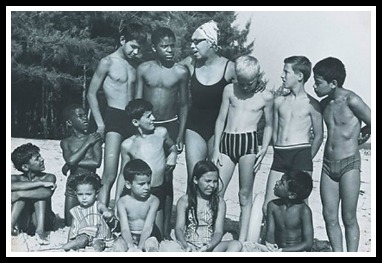
The tribe has grown and are growing up
On the other hand, she was doing civil rights work all over the world as she was touring . She even spoke with Martin Luther King, Jr at the March on Washington as the only official woman speaker.

Josephine at the March on Washington
So what hand won?

Josephine after being forced out of Les Milandes
Not Les Milandes. She got physically tossed out of it. But that’s again, not the end. Over the next few years, in not so short order: Princess Grace rescued her, helped set her up in a sweet villa in Monaco and funds a comeback show.
Opening night in Paris. It’s April, 1975 and Josephine is 68 years old. Does the old girl still have what it takes, or has Paris already seen the best she had to offer years before? Is she a washed up has-been, or a timeless superstar?
When the reviews came in the roaring cry was… Superstar!
Josephine was back on the stage, the cheers of the crowd ringing in her ears- she was a success.
The next day, no one could wake her as she lay among her rave reviews in the papers. She would never awake again. Within the week she was declared dead of a brain hemorrhage on April 12, 1975.

Josephine’s funeral procession through the streets of Paris
Fin
TIME TRAVEL WITH THE HISTORY CHICKS

You can visit Les Milandes without ever leaving your house! This is a really fun website and one of the few where we don’t mind music. Les Milandes Website.
If you are leaving your house and headed to New York, maybe you can dine at Chez Josephine, NYC.
Although her life really reads like a movie, this is the one movie that we could get our hands on: 1991 The Josephine Baker Story starring Lynn Whitfield.
We know you like your books and here are the ones that we recommend for this woman:
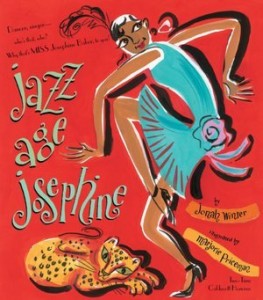
Children’s book: Jazz Age Josephine by Jonah Winter illustrated by Marjorie Priceman
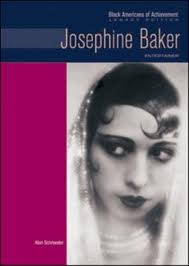
Middle Grade-Josephine Baker: Entertainer by Alan Schroeder
Have your own compare and contrast fest with these three biographies:
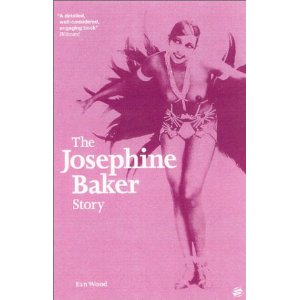
The Josephine Baker Story by Ean Wood
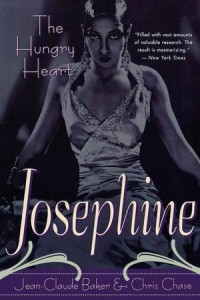
Josephine Baker: The Hungry Heart by Jean-Claude Baker and Chris Chase
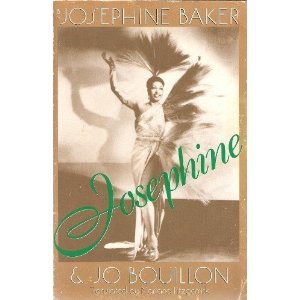
Josephine by Josephine Baker and Jo Bouillion

Josephine Baker: Image and Icon by Olivia Gonzales
As always, our music comes courtesy of Music Alley. Visit them at Music.mevio.com






































